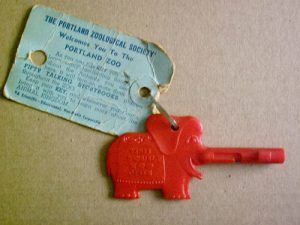Augmented reality electronic literature is a very exciting divergent stream of electronic literature because it may be the easiest genre electronic literature to immediately see real world applications for, by benefit of what it is. Enhancing reality by making more information available about an individual’s surroundings is one of the most exciting fronts of digital technology as many existing experiences and events can be vastly improved in constantly growing ways by digital technology.

The Oregon Zoo installed their first zoo key system in 1970 and still uses a system installed in 1984 today (I had a lot of trouble finding a reliable source on this, they may have updated their system since). The zoo key program is a collection of audio boxes paired with animal enclosures and exhibits that will play a message containing information about the animal or exhibit upon insertion of the plastic zoo key. The current setup is nostalgic and the physical aspect of having a key and finding the audio boxes is great and shouldn’t be replaced, but the system could be improved and regularly updated by placing unique QR code stickers on each box and allowing visitors to receive much more information than audio on their phones, similar to the “Yellow Arrow Project”s unique numeric identifiers. GPS could be used in this system as well, making information available to users upon entering an exhibit or area of the zoo. The zoo key project is directed at young children, so incorporating children’s stories would be a natural addition to the current system.
Museums, galleries, zoos, and many other destinations have physical placards for information in addition to audio tour systems. Places whose goal is to inform must balance including as much information as they can and making placards easy and enjoyable to read for a wide audience. Many people will leave a placard wanting to know more about a topic or having skimmed the placard and retained nothing because it was too verbose. Making the information available on your phone allows organizations to include summaries, short, and long form pieces of information for each location, to allow the audience to choose the right amount of content for them, as well as being able to link out to outside sources. Audio systems are often expensive to rent or clunky to carry around, depending on how new the system is. Navigating audio tours can be frustrating depending on the system. In art galleries for example, an audio tour could be divided as broadly as 20 minute chunks of audio per exhibit, or two to ten minutes recordings per piece. No matter how minutely a physical audio device divides an exhibit, it still cannot tell you what will be contained in each individual recording and where the information will be in each recording. Parsing through audio recordings is always easier with time stamps and context which can be provided more easily on a phone than on a physical device.
In all the ways augmented reality can be used to increase the dispersal of factual information and nonfiction, it can be used for literature as well. Augmented reality makes room for literature in spaces where space for information is at a premium, physical space or audio wise. Incorporating narratives in spaces such as art galleries and museums allows these spaces to manipulate wayfinding and exploration of their spaces through apps they can update regularly.
Rettberg mentions “dérive, a practice of consciously breaking habits of movement and interaction with (a location)”
A place like the Oregon zoo or OMSI could publish a physical children’s book and/or app about their space that allows visitors to explore the place by following the locations in the narrative along with the location. The zoo could guide visitors through the park based on the level of activity in animals based on the season or time of day, releasing a new narrative every season to attract visitors year-round. Zoolights would be a great opportunity for this as well, a new holiday themed story could be paired with the lights every year. Augmented reality allows organizations to include literature in their spaces in ways they could not while having to prioritize space for information.